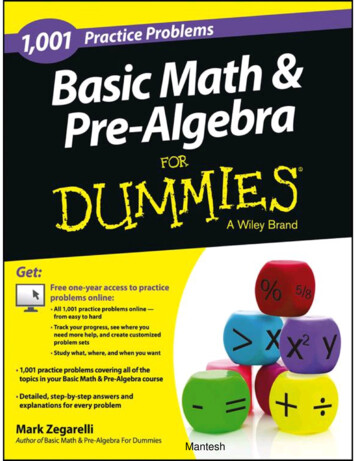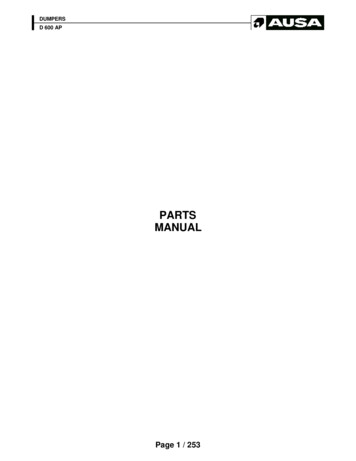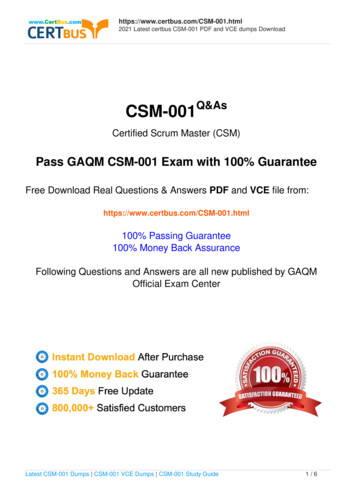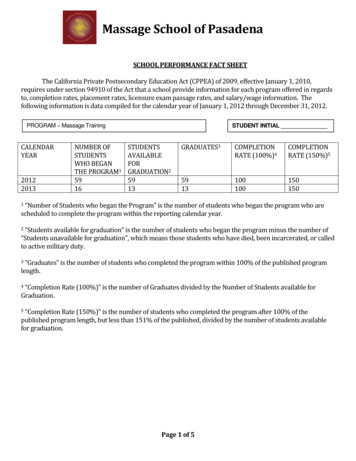
Transcription
Mantesh
Published byJohn Wiley & Sons, Inc.111 River St.Hoboken, NJ 07030-5774www.wiley.comCopyright 2013 by John Wiley & Sons, Inc., Hoboken, New JerseyPublished by John Wiley & Sons, Inc., Hoboken, New JerseyPublished simultaneously in CanadaNo part of this publication may be reproduced, stored in a retrieval system or transmitted inany form or by any means, electronic, mechanical, photocopying, recording, scanning orotherwise, except as permitted under Sections 107 or 108 of the 1976 United StatesCopyright Act, without the prior written permission of the Publisher. Requests to thePublisher for permission should be addressed to the Permissions Department, John Wiley& Sons, Inc., 111 River Street, Hoboken, NJ 07030, (201) 748-6011, fax (201) 748-6008,or online at http://www.wiley.com/go/permissions.Trademarks: Wiley, the Wiley logo, For Dummies, the Dummies Man logo, A Referencefor the Rest of Us!, The Dummies Way, Dummies Daily, The Fun and Easy Way,Dummies.com, Making Everything Easier, and related trade dress are trademarks orregistered trademarks of John Wiley & Sons, Inc., and/or its affiliates in the United Statesand other countries, and may not be used without written permission. All other trademarksare the property of their respective owners. John Wiley & Sons, Inc., is not associated withany product or vendor mentioned in this book.Limit of Liability/Disclaimer of Warranty: The publisher and the author make norepresentations or warranties with respect to the accuracy or completeness of the contentsof this work and specifically disclaim all warranties, including without limitationwarranties of fitness for a particular purpose. No warranty may be created or extended bysales or promotional materials. The advice and strategies contained herein may not besuitable for every situation. This work is sold with the understanding that the publisher isnot engaged in rendering legal, accounting, or other professional services. If professionalassistance is required, the services of a competent professional person should be sought.Neither the publisher nor the author shall be liable for damages arising herefrom. The factthat an organization or Website is referred to in this work as a citation and/or a potentialsource of further information does not mean that the author or the publisher endorses theinformation the organization or Website may provide or recommendations it may make.Further, readers should be aware that Internet Websites listed in this work may havechanged or disappeared between when this work was written and when it is read.For general information on our other products and services, please contact our CustomerCare Department within the U.S. at 877-762-2974, outside the U.S. at 317-572-3993, or fax
317-572-4002.For technical support, please visit www.wiley.com/techsupport.Wiley publishes in a variety of print and electronic formats and by print-on-demand. Somematerial included with standard print versions of this book may not be included in e-booksor in print-on-demand. If this book refers to media such as a CD or DVD that is notincluded in the version you purchased, you may download this material athttp://booksupport.wiley.com. For more information about Wiley products, visitwww.wiley.com.Library of Congress Control Number: 2013932103ISBN 978-1-118-44656-0 (pbk); ISBN 978-1-118-44645-4 (ebk); ISBN 978-1-11844653-9 (ebk); ISBN 978-1-118-44654-6 (ebk)Manufactured in the United States of America10 9 8 7 6 5 4 3 2 1
About the AuthorMark Zegarelli is the author of Basic Math & Pre-Algebra For Dummies, Calculus II ForDummies, and five other books on math, logic, and test preparation. He holds degrees inboth English and math from Rutgers University and is a math tutor and teacher.Mark lives in San Francisco, California, and Long Branch, New Jersey.
DedicationThis is for Suleiman.Author’s AcknowledgmentsThis is my eighth For Dummies book and, as always, the experience of writing it has beenproductive and fun. Thanks so much to editors Tim Gallan, Christy Pingleton, LindsayLefevere, Shira Fass, and Suzanne Langebartels for setting me right as needed.And thanks to the folks at Borderlands Café on Valencia Street in San Francisco for thefriendly, peaceful, and caffeine-accessible environment that virtually any writer (this one,for example) would find conducive to putting actual words on paper.
Publisher’s AcknowledgmentsWe’re proud of this book; please send us your comments at http://dummies.custhelp.com.For other comments, please contact our Customer Care Department within the U.S. at 877762-2974, outside the U.S. at 317-572-3993, or fax 317-572-4002.Some of the people who helped bring this book to market include the following:Acquisitions, Editorial, and Vertical WebsitesSenior Project Editor: Tim GallanExecutive Editor: Lindsay Sandman LefevereCopy Editors: Suzanne Langebartels, Christine PingletonAssistant Editor: David LuttonEditorial Program Coordinator: Joe NiesenTechnical Editor: Shira FassEditorial Manager: Michelle HackerEditorial Assistants: Rachelle S. Amick, Alexa KoschierCover Photos: Sandra van der Steen/iStockphoto.comComposition ServicesSenior Project Coordinator: Kristie ReesLayout and Graphics: Carrie A. Cesavice, Shawn Frazier, Erin ZeltnerProofreaders: Jacqui Brownstein, Dwight RamseyIndexer: Potomac Indexing, LLCPublishing and Editorial for Consumer DummiesKathleen Nebenhaus, Vice President and Executive PublisherDavid Palmer, Associate PublisherKristin Ferguson-Wagstaffe, Product Development DirectorPublishing for Technology Dummies
Andy Cummings, Vice President and PublisherComposition ServicesDebbie Stailey, Director of Composition Services
1,001BasicMath&Problems For Dummies Pre-AlgebraPracticeVisit ra to view this book'scheat sheet.Table of ContentsIntroductionWhat You’ll FindHow This Workbook Is OrganizedPart I: QuestionsPart II: AnswersBeyond the BookWhat you’ll find onlineHow to registerWhere to Go for Additional HelpPart I: The QuestionsChapter 1: The Big Four OperationsThe Problems You’ll Work OnWhat to Watch Out ForChapter 2: Less than Zero: Working with Negative NumbersThe Problems You’ll Work OnWhat to Watch Out ForChapter 3: You’ve Got the Power: Powers and RootsThe Problems You’ll Work OnWhat to Watch Out ForChapter 4: Following Orders: Order of OperationsThe Problems You’ll Work OnWhat to Watch Out ForMantesh
Chapter 5: Big Four Word ProblemsThe Problems You’ll Work OnWhat to Watch Out ForChapter 6: Divided We StandThe Problems You’ll Work OnWhat to Watch Out ForChapter 7: Factors and MultiplesThe Problems You’ll Work OnWhat to Watch Out ForChapter 8: Word Problems about Factors and MultiplesThe Problems You’ll Work OnWhat to Watch Out ForChapter 9: FractionsThe Problems You’ll Work OnWhat to Watch Out ForChapter 10: DecimalsThe Problems You’ll Work OnWhat to Watch Out ForChapter 11: PercentsThe Problems You’ll Work OnWhat to Watch Out ForChapter 12: Ratios and ProportionsThe Problems You’ll Work OnWhat to Watch Out ForChapter 13: Word Problems for Fractions, Decimals, and PercentsThe Problems You’ll Work OnWhat to Watch Out ForMantesh
Chapter 14: Scientific NotationThe Problems You’ll Work OnWhat to Watch Out ForChapter 15: Weights and MeasuresThe Problems You’ll Work OnWhat to Watch Out ForChapter 16: GeometryThe Problems You’ll Work OnWhat to Watch Out ForChapter 17: GraphingThe Problems You’ll Work OnWhat to Watch Out ForChapter 18: Statistics and ProbabilityThe Problems You’ll Work OnWhat to Watch Out ForChapter 19: Set TheoryThe Problems You’ll Work OnWhat to Watch Out ForChapter 20: Algebraic ExpressionsThe Problems You’ll Work OnWhat to Watch Out ForChapter 21: Solving Algebraic EquationsThe Problems You’ll Work OnWhat to Watch Out ForChapter 22: Solving Algebra Word ProblemsThe Problems You’ll Work OnWhat to Watch Out ForMantesh
Part II: The AnswersChapter 23: AnswersAnswers 1 - 100Answers 101 - 200Answers 201 - 300Answers 301 - 400Answers 401 - 500Answers 501 - 600Answers 601 - 700Answers 701 - 800Answers 801 - 900Answers 901 - 1001Cheat Sheet
IntroductionAre you kidding . . . 1,001 math problems, really?That’s right, a thousand questions plus one to grow on, here in your hot little hands. I’vearranged them in order, starting with beginning arithmetic and ending with basic algebra.Topics include everything from the Big Four operations (adding, subtracting, multiplying,and dividing), through negative numbers and fractions, on to geometry and probability, andfinally algebra — plus lots more!Every chapter provides tips for solving the problems in that chapter. And, of course, theback of the book includes detailed explanations of the answers to every question.It’s all here, so get to work!What You’ll FindThis book includes 1,001 basic math and pre-algebra problems, divided into 22 chapters.Each chapter contains problems focusing on a single math topic, such as negative numbers,fractions, or geometry.Within each chapter, topics are broken into subtopics so that you can work on a specifictype of math skill until you feel confident with it. Generally speaking, each section startswith easy problems, moves on to medium ones, and then finishes with hard problems.You can jump right in anywhere you like and solve these problems in any order. You canalso take on one chapter or section at a time, working from easy to medium to hardproblems. Or, if you like, you can begin with Question #1 and move right through toQuestion #1,001.Additionally, each chapter begins with a list of tips for answering the questions in thatchapter.Every question in Part I is answered in Part II, with a full explanation that walks youthrough how to understand, set up, and solve the problem.How This Workbook Is OrganizedThis workbook includes 1,001 questions in Part I and answers to all of these questions inPart II.Part I: QuestionsHere are the topics covered by the 1,001 questions in this book:Basic arithmetic: In Chapters 1 through 5, you find dozens of basic arithmeticproblems. Chapter 1 begins with rounding numbers and then moves on to basic calculatingwith addition, subtraction, multiplication, and division. Then, in Chapter 2, you tacklenegative numbers, and in Chapter 3, you move on to working with powers and square roots.Chapter 4 gives you plenty of practice in solving arithmetic problems using the order of
operations. You may remember this using the mnemonic PEMDAS — Parentheses,Exponents, Multiplication and Division, Addition and Subtraction.Finally, in Chapter 5, you put all of this information together to answer arithmeticword problems, from easy to challenging.Divisibility, factors, and multiples: Chapters 6, 7, and 8 cover a set of topics related todivisibility. In Chapter 6, you discover a variety of divisibility tricks, which allow you tofind out whether a number is divisible by another without actually doing the division. Youalso work with division with remainders and understand the distinction between prime andcomposite numbers.Chapter 7 focuses on factors and multiples. You discover how to generate all thefactors and prime factors of a number and calculate the greatest common factor (GCF)for a set of two or more numbers. Additionally, you generate a partial list of themultiples, and calculate the least common multiple (LCM) of two or more numbers.Chapter 8 wraps up the section with word problems that sharpen and extend yourskills working with factors, multiples, remainders, and prime numbers.Fractions, decimals, percents, and ratios: Chapters 9 through 13 focus on four distinctways to represent parts of a whole — fractions, decimals, percents, and ratios. In Chapter9, you work with fractions, including increasing the terms of fractions and reducing them tolowest terms. You change improper fractions to mixed numbers, and vice versa. You add,subtract, multiply, and divide fractions, including mixed numbers. You also simplifycomplex fractions.In Chapter 10, you convert fractions to decimals, and vice versa. You add, subtract,multiply, and divide decimals. You also find out how to work with repeatingdecimals. Chapter 11 focuses on percents. You convert fractions and multiples topercents, and vice versa. You discover a few tricks for calculating simple percents.You also work on more difficult percent problems by creating word equations, whichcan then be translated into equations and solved.Chapter 12 presents a variety of problems, including word problems, that use ratiosand proportions. And in Chapter 13, you tackle even more word problems where youapply your skills working with fractions, decimals, and percents.Scientific notation, weights and measures, geometry, graphs, statistics andprobability, and sets: In Chapters 14 through 19, you take a great stride forward workingwith a wide variety of intermediate basic math skills. In Chapter 14, the topic is scientificnotation, which is used to represent very large and very small numbers. Chapter 15introduces you to weights and measures, focusing on the English and metric systems, andconversions between the two. Chapter 16 gives you a huge number of geometry problems ofevery description, including both plane and solid geometry. In Chapter 17, you work with avariety of graphs, including bar graphs, pie charts, line graphs, pictographs, and the xygraph that is used so much in algebra and later math.Chapter 18 gives you an introduction to basic statistics, including the mean, median,and mode. It also provides problems in probability and gives you an introduction tocounting both independent and dependent events. Chapter 19 gives you some problems
in basic set theory, including finding the union, intersection, relative complement, andcomplement. Additionally, you use Venn diagrams to solve word problems.Algebraic expressions and equations: To finish up, Chapters 20, 21, and 22 give you ataste of the work you’ll be doing in your first algebra class. Chapter 20 shows you thebasics of working with algebraic expressions, including evaluating, simplifying, andfactoring. In Chapter 21, you solve basic algebraic equations. And in Chapter 22, you putthese skills to use, solving a set of word problems with basic algebra.Part II: AnswersIn this part, you find answers to all 1,001 questions that appear in Part I. Each answercontains a complete step-by-step explanation of how to solve the problem from beginningto end.Beyond the BookThis book gives you plenty of math to work on and prepares you for algebra. But maybe youwant to track your progress as you tackle the problems, or maybe you’re having troublewith certain types of problems and wish they were all presented in one place where youcould methodically make your way through them. You’re in luck. Your book purchasecomes with a free one-year subscription to all 1,001 practice problems online. You get onthe-go access any way you want it — from your computer, smartphone, or tablet. Trackyour progress and view personalized reports that show where you need to study the most.And then do it. Study what, where, when, and how you want.What you’ll find onlineThe online practice that comes free with this book offers you the same 1,001 questions andanswers that are available here, presented in a multiple-choice format. The beauty of theonline problems is that you can customize your online practice to focus on the topic areasthat give you the most trouble. So if you need help converting fractions to decimals or havetrouble grasping pre-algebra, then select these problem types online and start practicing.Or, if you’re short on time but want to get a mixed bag of a limited number of problems, youcan specify the quantity of problems you want to practice. Whether you practice a fewhundred problems in one sitting or a couple dozen, and whether you focus on a few types ofproblems or practice every type, the online program keeps track of the questions you getright and wrong so that you can monitor your progress and spend time studying exactly whatyou need.You can access this online tool using a PIN code, as described in the next section. Keep inmind that you can create only one login with your PIN. Once the PIN is used, it’s no longervalid and is nontransferable. So you can’t share your PIN with other users after you’veestablished your login credentials.How to registerPurchasing this book entitles you to one year of free access to the online, multiple-choiceversion of all 1,001 of this book’s practice problems. All you have to do is register. Just
follow these simple steps:1. Find your PIN code. Print book users: If you purchased a hard copy of this book, turn to the back of thisbook to find your PIN. E-book users: If you purchased this book as an e-book, you can get your PIN byregistering your e-book at dummies.com/go/getaccess. Go to this website, find yourbook and click it, and then answer the security question to verify your purchase. Thenyou’ll receive an e-mail with your PIN.2. Go to onlinepractice.dummies.com.3. Enter your PIN.4. Follow the instructions to create an account and establish your own logininformation.That’s all there is to it! You can come back to the online program again and again — simplylog in with the username and password you choose during your initial login. No need to usethe PIN a second time.If you have trouble with the PIN or can’t find it, please contact Wiley Product TechnicalSupport at 800-762-2974 or http://support.wiley.com.Your registration is good for one year from the day you activate your PIN. After thattime frame has passed, you can renew your registration for a fee. The website gives you all theimportant details about how to do so.Where to Go for Additional HelpEvery chapter in this book opens with tips for solving the problems in that chapter. And, ofcourse, if you get stuck on any question, you can flip to the answer section and try to workthrough the solution provided. However, if you feel that you need a bit more basic mathinformation than this book provides, I highly recommend my earlier book Basic Math &Pre-Algebra For Dummies. This book gives you a ton of useful information for solvingevery type of problem included here.Additionally, you can also check out my Basic Math & Pre-Algebra Workbook ForDummies. It contains a nice mix of short explanations for how to do various types ofproblems, followed by practice. And, for a quick take on the most important basic mathconcepts, have a look at Basic Math & Pre-Algebra Essentials For Dummies. Yep, Iwrote that one, too — how’s that for shameless plugs?
Part IThe QuestionsVisit www.dummies.com for great Dummies content online
In this part . . .One thousand and one math problems. That’s one problem for every night in the ArabianNights stories. That’s almost ten problems for every floor in the Empire State Building. Inshort, that’s a lot of problems — plenty of practice to help you attain the math skills youneed to do well in your current math class. Here’s an overview of the types of questionsprovided:Basic arithmetic, including absolute value, negative numbers, powers, and square roots(Chapters 1 through 5)Divisibility, factors, and multiples (Chapters 6 through 8)Fractions, decimals, percents, and ratios (Chapters 9 through 13)Scientific notation, measures, geometry, graphs, statistics, probability, and sets(Chapters 14 through 19)Algebraic expressions and equations (Chapters 20 through 22)
Chapter 1The Big Four OperationsThe Big Four operations (adding, subtracting, multiplying, and dividing) are the basis forall of arithmetic. In this chapter, you get plenty of practice working with these importantoperations.The Problems You’ll Work OnHere are the types of problems you find in this chapter:Rounding numbers to the nearest ten, hundred, thousand, or millionAdding columns of figures, including addition with carryingSubtracting one number from another, including subtraction with borrowingMultiplying one number by anotherDivision, including division with a remainderWhat to Watch Out ForHere’s a quick tip for rounding numbers to help you in this chapter: When rounding anumber, check the number to the right of the place you’re rounding to. If that number is from0 to 4, round down by changing that number to 0. If that number is from 5 to 9, round up bychanging that number to 0 and adding 1 to the number to its left.For example, to round 7,654 to the nearest hundred, check the number to the right of thehundreds place. That number is 5, so change it to 0 and add 1 to the 6 that’s to the left of it.Thus, 7,654 becomes 7,700.Rounding1–61. Round the number 136 to the nearest ten.2. Round the number 224 to the nearest ten.3. Round the number 2,492 to the nearest hundred.
4. Round the number 909,090 to the nearest hundred.5. Round the number 9,099 to the nearest thousand.6. Round the number 234,567,890 to the nearest million.Adding, Subtracting, Multiplying, and Dividing7–307. Add 47 21 ?8. Add 136 53 77 ?9. Add 735 246 1,329 ?10. Add 904 1,024 6,532 883 ?11. Add 56,702 821 5,332 89 343,111 ?12. Add 1,609,432 657,936 82,844 2,579 459 ?13. Subtract 89 – 54 ?14. Subtract 373 – 52 ?15. Subtract 539 – 367 ?16. Subtract 2,468 – 291 ?17. Subtract 34,825 – 26,492 ?
18. Subtract 71,002 – 56,234 ?19. Multiply20. Multiply21. Multiply22. Multiply23. Multiply24. Multiply25. Divide26. Divide27. Divide28. Divide29. Divide30. Divide
Chapter 2Less than Zero: Working with Negative NumbersNegative numbers can be a cause of negativity for some students. The rules for workingwith negative numbers can be a little tricky. In this chapter, you practice applying the BigFour operations to negative numbers. You also strengthen your skills evaluating absolutevalue.The Problems You’ll Work OnThis chapter shows you how to work with the following types of problems:Subtracting a smaller number minus a larger numberAdding and subtracting with negative numbersMultiplying and dividing with negative numbersEvaluating absolute valueWhat to Watch Out ForHere are a few things to keep an eye out for when you’re working with negative numbers:To subtract a smaller number minus a larger number, reverse and negate: Reverse bysubtracting the larger number minus the smaller one, and then negate by attaching a minussign (–) in front of the result. For example, 4 – 7 –3.To subtract a negative number minus a positive number, add and negate: Add the twonumbers as if they were positive, then negate by attaching a minus sign in front of the result.For example, –5 – 4 –9.To add a positive number and a negative number (in either order), subtract the largernumber minus the smaller number; then attach the same sign to the result as the number thatis farther from 0. For example, –3 5 2 and 4 (–6) –2.Adding and Subtracting Negative Numbers31–4131. Evaluate each of the following.i.ii.
iii.iv.v.32. Evaluate each of the following.i.ii.iii.iv.v.33. Evaluate each of the following.i.ii.iii.iv.v.34. Evaluate each of the following.i.ii.iii.iv.v.35. Evaluate each of the following.i.ii.
iii.iv.v.36.37.38.39.40.41.Multiplying and Dividing Negative Numbers42–5342. Evaluate each of the following.i.ii.iii.iv.v.43.44.Mantesh
45.46.47.48.49. Evaluate each of the following.i.ii.iii.iv.v.50.51.52.53.Working with Absolute Value54–5754. Evaluate each of the following.i.ii.
iii.iv.v.55.56.57.
Chapter 3You’ve Got the Power: Powers and RootsPowers provide a shorthand notation for multiplication using a base number and anexponent. Roots — also called radicals — reverse the process of powers. In this chapter,you practice taking powers and roots of positive integers as well as fractions and negativeintegers.The Problems You’ll Work OnThis chapter deals with the following types of problems:Using powers to multiply a number by itselfApplying exponents to negative numbers and fractionsUnderstanding square rootsKnowing how to evaluate negative exponents and fractional exponentsWhat to Watch Out ForFollowing are some tips for working with powers and roots:When you find the power of a number, multiply the base by itself as many times asindicated by the exponent. For example,.When the base is a negative number, use the standard rules of multiplication for negativenumbers (see Chapter 2). For example,.When the base is a fraction, use the standard rules of multiplication for fractions (seeChapter 9). For example,.To find the square root of a square number, find the number that, when multiplied byitself, results in the number you started with. For example,, because.To simplify the square root of a number that’s not a square number, if possible, factorout a square number and then evaluate it. For example,.Evaluate an exponent of as the square root of the base. For example,Evaluate an exponent of –1 as the reciprocal of the base. For example,.To evaluate an exponent of a negative number, make the exponent positive and evaluateits reciprocal. For example,.Multiplying a Number by Itself
58–7258. Evaluate each of the following.i.ii.iii.iv.v.59.60.61.62.63.64.65. Evaluate each of the following.i.ii.iii.iv.v.66.
67.68.69. Evaluate each of the following.i.ii.iii.iv.v.70.71.72.Finding Square Roots73–7973. Simplify each of the following as a whole number by finding the square root.i.ii.iii.iv.
v.74. Simplify each of the following as a whole number by finding the square root and ive and Fractional Exponents80–9080. Express each of the following as a square root and then simplify as a positive whole number.i.ii.iii.iv.v.
81.82.83.84.85. Simplify each of the following as a fraction.i.ii.iii.iv.v.86.87.88.89.90.
Chapter 4Following Orders: Order of OperationsThe order of operations (also called the order of precedence) provides a clear way toevaluate complex expressions so you always get the right answer. The mnemonic PEMDAShelps you to remember to evaluate parentheses first; then move on to exponents; thenmultiplication and division; and finally addition and subtraction.The Problems You’ll Work OnThis chapter includes these types of problems:Evaluating expressions that contain the Big Four operations (addition, subtraction,multiplication, and division)Evaluating expressions that include exponentsEvaluating expressions that include parentheses, including nested parenthesesEvaluating expressions that include parenthetical expressions, such as square roots andabsolute valueEvaluating expressions that include fractions with expressions in the numerator and/ordenominatorWhat to Watch Out ForKeep the following tips in mind as you work with the problems in this chapter:When an expression has only addition and subtraction, evaluate it from left to right. Forexample, 8 – 5 6 3 6 9.When an expression has only multiplication and division, evaluate it from left to right.For example,.When an expression has any combination of the Big Four operations, first evaluate allmultiplication and division from left to right; then evaluate addition and subtraction fromleft to right. For example,.When an expression includes powers, evaluate them first, and then evaluate Big Fouroperations. For example,.The Big Four Operations91–102
91. 8 9 – 3 92. –5 – 10 3 – 4 93.94.95.96.97.98.99.100.101.102.Operations with Exponents103–112103.104.
105.106.107.108.109.110.111.112.Operations with Parentheses113–124113.114.115.116.117.118.
119.120.121.122.123.124.Operations with Square Roots125–134125.126.127.128.129.130.131.132.
133.134.Operations with ns with Absolute Values141–144141.142.
143.144.
Chapter 5Big Four Word ProblemsWord problems provide an opportunity for you to apply your math skills to real-worldsituations. In this chapter, all the problems can be solved using the Big Four operations(adding, subtracting, multiplying, and dividing).The Problems You’ll Work OnThe problems in this chapter fall into three basic categories, based on their difficulty:Basic word problems where you need to perform a single operationIntermediate word problems where you need to use two different operationsTricky word problems that require several different operations and more difficultcalculationsWhat to Watch Out ForHere are a few tips for getting the right answer to word problems:Read each problem carefully to make sure you understand what it’s asking.Use scratch paper to gather and organize information from the problem.Think about which Big Four operation (adding, subtracting, multiplying, or dividing)will be most helpful for solving the problem.Perform calculations carefully to avoid mistakes.Ask yourself whether the answer you got makes sense.Check your work to make sure you’re right.Basic Word Problems145–154145. A horror movie triple-feature included Zombies Are Forever, which was 80 minutes long, AnAmerican Werewolf in Bermuda, which ran for 95 minutes, and Late Night Snack of the Vampire,which was 115 minutes from start to finish. What was the total length of the three movies?146. At a height of 2,717 feet, the tallest building in the world is the Burj Khalifa in Dubai. It’s1,263 feet taller than the Empire State Building in New York City. What is the height of the Empire
State Building?147. Janey’s six children are making colored eggs for Easter. She bought a total of five dozen eggsfor all of the children to use. Assuming each child gets the same number of eggs, how many eggsdoes each child receive?148. Arturo worked a 40-hour week at 12 per hour. He then received a raise of 1 per hour andworked a 30-hour week. How much more money did he receive for the first week of work than thesecond?149. A restaurant has 5 tables that seat 8 people each, 16 tables with room for 6 people each, and 11tables with room for 4 people each. What is the total capacity of all the tables at the restaurant?150.
10 9 8 7 6 5 4 3 2 1. About the Author Mark Zegarelli is the author of Basic Math & Pre-Algebra For Dummies, Calculus II For . This book includes 1,001 basic math and pre-algebra problems, divided into 22 chapters. Each chapter contains problems focusing on a single math topic, such as negative numbers, fractions, or geometry.








